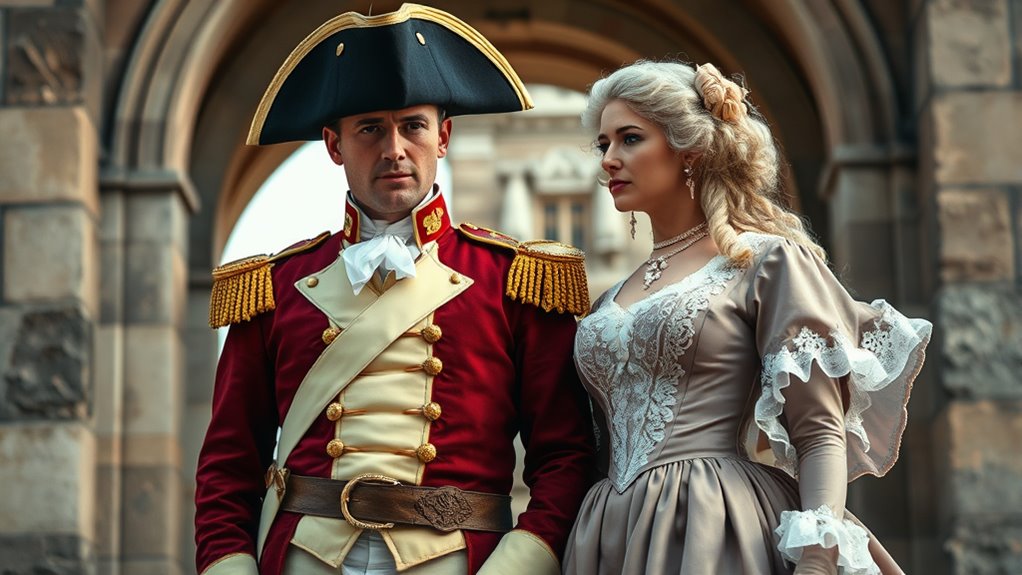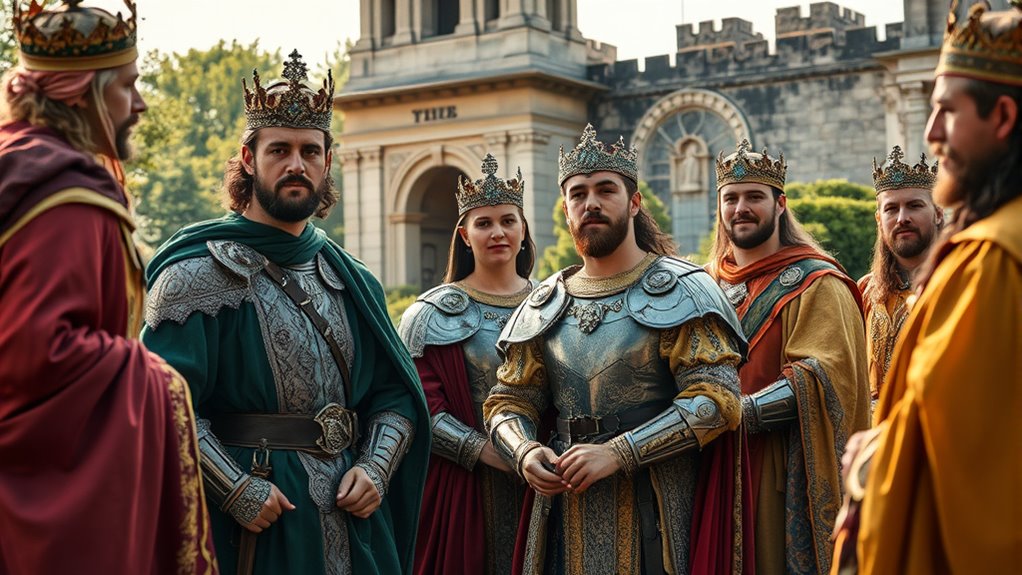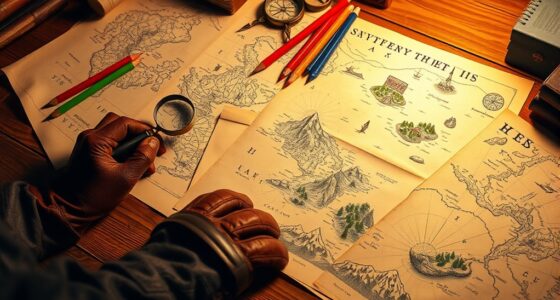To reenact famous events convincingly, you need authentic historical costumes that accurately reflect the period. Focus on details like fabric choices, accessories, and proper construction techniques to bring your character to life. Research the era thoroughly to avoid modern anachronisms and guarantee your outfit captures the true spirit of the time. Investing effort in authentic costume creation enhances immersion and realism. If you keep exploring, you’ll discover even more ways to perfect your historical dress-up.
Key Takeaways
- Research and select accurate costumes representing the specific historical event or era.
- Use authentic fabrics, accessories, and construction techniques to ensure period accuracy.
- Pay close attention to details like silhouettes, trims, and fastenings to enhance realism.
- Incorporate traditional dyeing, sewing, and layering methods for authentic appearance.
- Invest time in crafting convincing costumes to improve immersion and showcase dedication to history.

Dressing up in historical costumes isn’t just about fashion; it’s a fun way to connect with the past. When you immerse yourself in creating a costume for reenacting famous events, you’re engaging in more than just putting on clothes—you’re bringing history to life. The key to making your portrayal convincing lies in careful costume construction and prioritizing era accuracy. These elements ensure that your outfit isn’t just visually appealing but also true to the period you’re representing.
Start with understanding the era you want to depict. Whether you’re recreating Victorian England, the Roaring Twenties, or medieval Europe, research is essential. Focus on details like fabric choices, accessories, and overall style. This research guides your costume construction process, helping you select appropriate materials and techniques. For example, using period-appropriate fabrics and hand-sewn details can elevate your costume’s authenticity. Avoid modern synthetic fabrics unless you’re intentionally blending styles; authentic materials help you achieve a look that’s true to the time period.
Research your chosen era thoroughly to select authentic fabrics, accessories, and construction techniques for a convincing costume.
Pay attention to era accuracy during the design process. Small details, such as the shape of a collar or the way a waistcoat fits, can make a significant difference. Examine historical photographs, paintings, and documents to understand the typical silhouette and ornamentation of the era. This knowledge helps you avoid anachronisms—clothing items or styles that don’t belong to the period—and guarantees your costume reflects the historical context accurately. If aiming for complete authenticity, learn about traditional construction methods used during that era. For instance, sewing techniques or dyeing processes can add an extra layer of realism.
Constructing a costume with authenticity in mind might take more time and effort but pays off when you see the finished product. Take the time to pattern your clothing based on period-specific designs. Think about layering, closures, and embellishments typical of the era, and use period-appropriate trims and fastenings. This attention to detail might seem minor but adds depth to your portrayal, making it more convincing and immersive. Remember, the goal isn’t just to look the part but to embody the spirit of the time you’re reenacting. Incorporating authentic costume construction techniques can significantly enhance the realism of your outfit.
Ultimately, successful historical dress-up hinges on your dedication to costume construction and era accuracy. When you put in the effort to research and craft your outfit meticulously, you preserve the authenticity of the event you’re reenacting. Your costume becomes a tangible link to history, enhancing your experience and helping others see and feel the past through your portrayal.
Frequently Asked Questions
What Are the Best Materials for Authentic Historical Costumes?
For authentic historical costumes, you should focus on fabric selection that matches the era, like linen, silk, or wool. These materials offer an authentic look and feel. Prioritize costume durability by choosing sturdy fabrics that withstand wear and tear during reenactments. Opt for natural fibers whenever possible, as they improve authenticity and comfort. Combining accurate fabric choices with durable materials guarantees your costume looks genuine and lasts through multiple performances.
How Do You Ensure Accuracy in Reenacting Specific Historical Events?
Did you know that 85% of reenactors rely on primary sources? To guarantee accuracy, you should start by studying these firsthand accounts, like letters or official documents. Additionally, consulting experts in the field provides valuable insights, helping you refine details. Cross-referencing multiple sources minimizes errors, so you recreate events faithfully. By combining primary sources and expert advice, you make your reenactments authentic and historically precise.
What Safety Precautions Are Necessary During Historical Dress-Up Activities?
When planning a historical dress-up event, you should prioritize costume safety by ensuring costumes fit well and don’t obstruct movement or vision. Use flame-resistant fabrics and avoid sharp accessories. During event planning, check for hazards like tripping risks or restricted exits. Always have a first aid kit on hand, and brief participants on safety measures. These precautions help create a fun, secure environment for everyone involved in the reenactment.
How Can I Create DIY Costumes for Different Eras?
You might find yourself unexpectedly inspired by thrift stores or your own closet for fabric selection, making DIY costumes easier and more authentic. Start by researching the era’s typical clothing styles, then gather suitable fabrics like cotton, silk, or wool. Don’t forget costume accessories—like hats, jewelry, or props—that add authenticity. With a little creativity and patience, you can craft impressive, era-accurate costumes that bring history to life effortlessly.
Are There Any Cultural Sensitivities to Consider in Historical Reenactments?
You should be aware of cultural misunderstandings and aim for respectful representation in historical reenactments. Research the event thoroughly, understand its cultural significance, and avoid stereotypes or misinterpretations. Consulting with community members or cultural experts can help guarantee your portrayal is respectful. Being mindful of sensitivities demonstrates respect, prevents offense, and enriches the educational value of your reenactment, making it more meaningful for everyone involved.
Conclusion
Stepping into history through dress-up isn’t just about costumes; it’s about becoming part of a story that transcends time. As you reenact these moments, remember you’re not just observing history—you’re living it. Like a thread woven into the fabric of the past, your participation keeps the legacy alive. So, embrace each costume and scene, for in doing so, you transform history from distant memory into a vivid, breathing experience that echoes through time.










